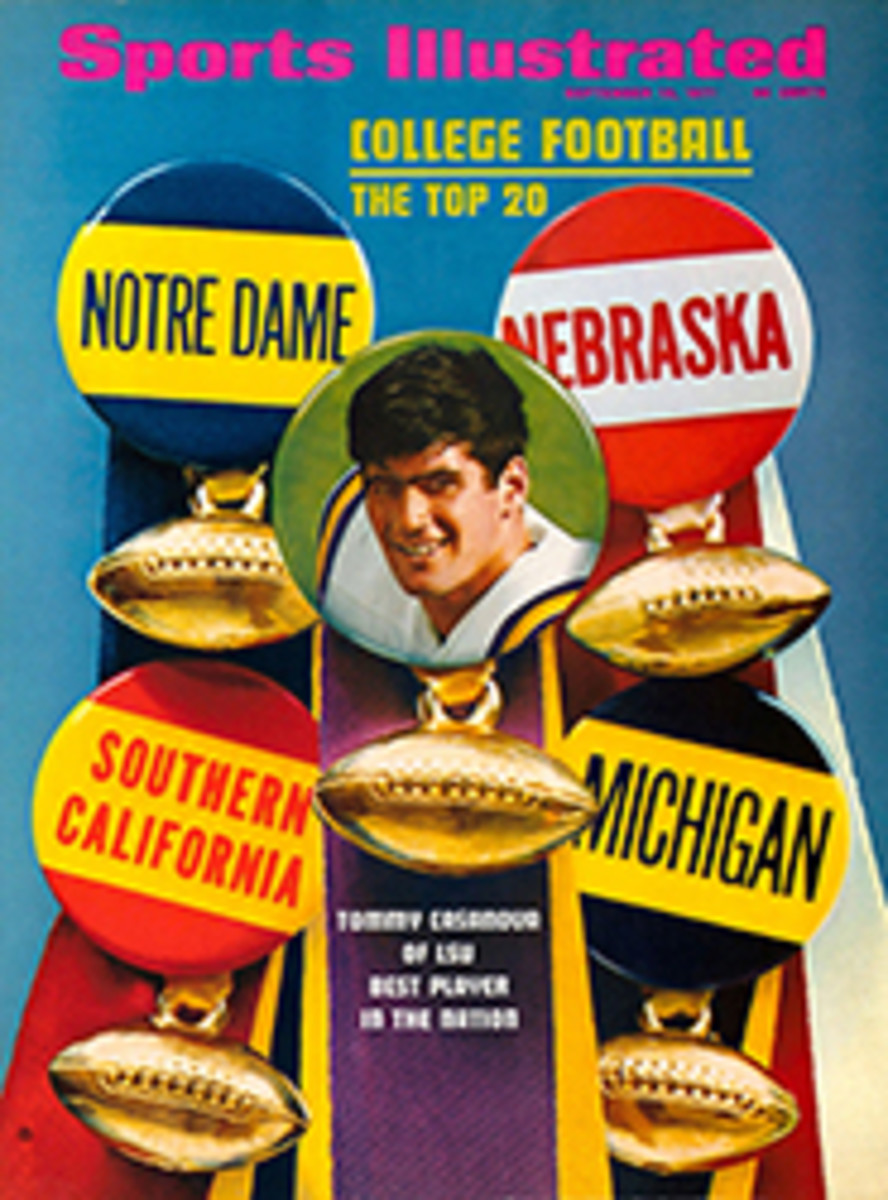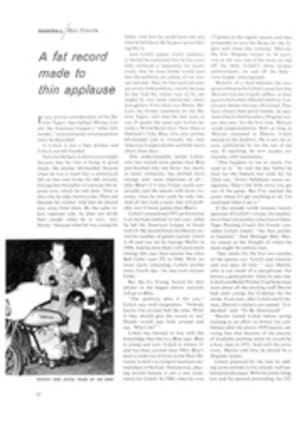
The First of the Fastest
A newspaper columnist in Chicago once called Al Tharnish the "first of the world's fastest men," which, like so many things, was not so much the truth as an elaboration of it. Al Tharnish was not the first of the world's fastest men, he was merely the first one to prove that he was.
He did this beginning one day in 1884, when Ringling Bros, circus stopped at Audubon, Iowa, Tharnish's home, and introduced, along with its other tented wonders, a swift attraction called The Ringling Flash, who—as "the world's fastest human"—challenged rubes from all over the countryside to a footrace. One of the rubes was Al Tharnish. Running barefoot and clad in overalls, Tharnish defeated the circus champion, despite the fact that his opponent had trained, was used to daily competition and wore spiked shoes.
Naturally, to keep the act alive, the circus hired Tharnish. During the next year he was Ringling Bros.' fastest star, and during the next eight years the world's greatest footracer, a claim he defended under a variety of names and in a score of guises—one week as a college star, the next as a pro, the following in a back-alley matched race. From 1884 to 1891 Al Tharnish never lost a race with a prize at stake, nor any race where he was given an even start—and he ran any distance from 50 yards to four miles.
Al Tharnish was born in Darien, N.Y. in 1868, but his family migrated from the East to open a livery stable and wagonyard when he was quite young. It was during his Midwestern boyhood that Tharnish discovered how fast he was; a young man soon learns he can do something better than his contemporaries, particularly when the something involves speed. Professor George I. Miller, who coached Audubon's football team, said Tharnish could run faster and jump farther than any boy he had ever seen.
When Tharnish was only 16 years old he was already established as the fastest runner and best football player in his section of Iowa. Then the circus came to town, and Tharnish was off and, well, running. In the midst of his circus tour, he met a man named Ed Moulton, who later trained Charlie Paddock, a more famous successor to the title of world's fastest human. Moulton saw better things for Tharnish and persuaded him to leave the circus.
It was a chancy move. Then, as now, there was no such thing as open track-and-field competition, but Tharnish campaigned as if there were. He was a regular fixture at collegiate meets, although he never enrolled in a university. But, he said, he ran for Yale and "every other college you can name." He also ran for various AAU teams, competed in any professional race he could find and went head to head with every challenger, usually with a handicapped start. For four years Tharnish and Moulton were never in a town longer than two days, but during that time they managed to clean the local sports of money, medals and most of the simpler satisfactions of winning.
Forty years later, commenting on his laissez-faire attitude toward amateur and professional competition, Tharnish said, "The word amateur gives me a pain. If they're good enough they're all being paid one way or another. I represented almost all the large colleges." Tharnish seemed proudest of running for Yale, often mentioning it to his children, although by applying makeup he also ran against Yale under the names George Strong, J. S. Wilson and a variety of other aliases.
Tracks of the era were much slower than today's artificial surfaces, and the shoes weighed considerably more than today's. Runners competed in a flannel covering from their necks to their knees, rather like long underwear. "We'd have been mobbed if we dared to step out on a track in a pair of shorts," Tharnish said. Despite these burdens, Tharnish ran the 100-yard dash in 9[4/5]. He ran 125 yards in 12 flat and 220 yards in 20⅕ all at or below existing world records. He boasted that no man lived who could beat him at 90 yards, although he did admit there was an occasional rare individual who might get a tie with him at 50.
The largest official prize Tharnish ever claimed for winning a race was $400 but flush gamblers usually sweetened the total and one of them once gave him $1,000 on the side. "I was always in shape, and they knew they could depend on me to win if there was money on the race," Tharnish explained. "I worked out every day at about five o'clock. After supper I would go out on the track again and run five to 10 miles just to be in shape if the occasion demanded. It built up endurance and stamina."
Tharnish ran in meets in New York, Boston, Detroit, Chicago, St. Louis and dozens of small communities throughout the Midwest and the West. The usual tactic was to allow the local talent to win an exhibition race, but when the money was on the line Tharnish ran away from the panting yokels. Then he and Moulton quickly vanished with their winnings. They also had a trick of greater subtlety ready if needed. Tharnish carried a 50-foot steel tape around with him that had been lengthened to 56 feet—making a 100-yard course actually 112 yards long. The extra distance was all Tharnish needed to make up for the 10-yard handicap he generally agreed to against the home-town amateur.
Tharnish's hand was never called when he was running for the colleges, but his appearance aroused the suspicion of the judges in the first Western AAU meet, held in Chicago. He was representing the Atlantic Athletic Club of Iowa, and hostile officials twice set him back behind the starting line—the custom in those days—for jumping the gun. Despite this harassment Tharnish won the 100, after which the exasperated judges still placed him in a tie for second and then set him so far back in the 220 he was never in the race.
Tharnish had some interesting theories about the sources of his talent, the most intriguing being his ability to hear. "I could hear the trigger mechanism of the starter's gun before the hammer fell. No one ever beat me on the start, and once I was away first it was like running a race by yourself," he said.
"Running is like life," Tharnish once said. "If you have the speed you don't have to tell the world. They'll find it out. You can make yourself think fast or slow. I preferred to think fast. I could run 100 yards backward in 10.2, faster than most men can run forward. That was just because I had trained my muscles to coordinate with my mind. Anyone can do the same. I had a stride of nine feet six inches with my right foot and nine feet four inches with my left. Try that some time and it may give you the secret of speed."
Tharnish, in 1934, thought a sprinter might one day run 100 yards in 9.1, but he indicated that was the ultimate. Nine seconds flat was not possible, he thought. So far at least he's right. "There seems to be a maximum speed, and no amount of exertion will cut down the resistance to an athlete's weight," he said.
Tharnish ran his last race in the summer of 1891 in St. Louis' old Sportsman's Park. He was sprinting for the finish line, leading as usual, when a spectator in the grandstand heaved a sandbag seat cushion at the track. The heavy bag struck Tharnish in the abdomen, just below his heart, knocking him unconscious. He never again felt any desire for running. Shortly afterward he married, which completed his retirement from the track, though he remained in training for five more years and stayed on a training diet for the rest of his life.
Tharnish did return to the public eye, briefly, to campaign for William Jennings Bryan in the Midwest, but there were few hurrahs left to sustain him. Even so, his son Joseph recalls that his father was an inordinately cheerful man who never despaired despite a series of misfortunes and his fading from public memory. Pursuing a new career, he studied watchmaking in Illinois and went into that business, but a jewelry store robbery in Iowa ruined him financially. He drifted south, to Jonesboro, Ark., and shortly afterward became a railroad watch inspector in Memphis, establishing himself as one of the finest engravers in the country. Secret Service agents often called upon him to identify suspected counterfeit currency.
In 1915 a streetcar accident paralyzed him for several months, and it was five years before he recovered. He died in Memphis on March 18, 1935 of a heart ailment. The obituaries said he was formerly the world's fastest human being and a member of Tennessee Watchmakers' Guild No. 4.

